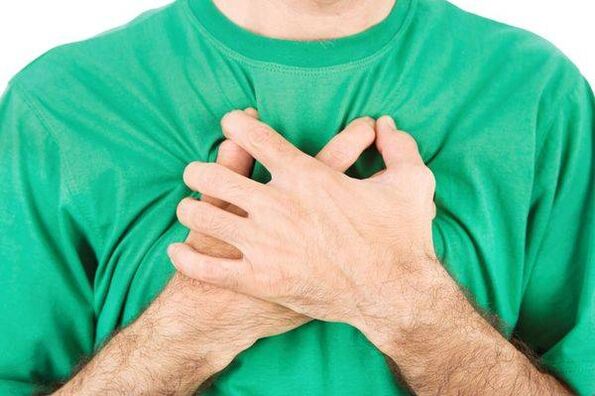Osteochondrosis is commonly called dystrophic changes in the bone and connective tissue of the spine. The spine is unable to cope with normal loads - and this is mainly expressed in the appearance of pain, at first not clearly expressed, but over time, increasing more and more.
The main symptoms of the disease
Thoracic osteochondrosis is a disease that usually appears in adulthood and does not fully manifest for a long time. This is due to the fact that the thoracic spine naturally supports and fixes the ribs - hence the intervertebral discs are provided with good protection.

The core of the spinal disc in this disease becomes thinner and dries out, the fibrous tissue around it begins to collapse, the cartilaginous tissue undergoes negative changes. The spine is unable to cope with normal loads - and this is mainly expressed in the appearance of pain, at first not clearly expressed, but over time, increasing more and more. However, with significant loads - sedentary lifestyle, sedentary work, constant stress, poor posture and back injuries - sooner or later osteochondrosis affects the thoracic region. The disease is considered very common - every third adult suffers from it.
What are the symptoms of thoracic osteochondrosis? First of all, in the occurrence of pains, which include:
- interscapular and intercostal neuralgic shots;
- pain in the left side of the chest;
- pain in the arms, aggravated by lifting them to the fingertips;
- pain when bending over;
In addition, thoracic osteochondrosis can be expressed in numbness - not only in the chest, but also in various parts of the body. Sometimes osteochondrosis leads to speech disorders and sometimes it even causes flaky skin, brittle nails, itchy skin and digestive disorders.
Pain in osteochondrosis of the chest can manifest itself in different ways. Sometimes they are light stabbing or dull aches that manifest in the late afternoon and disappear after physical activity - for example, a short walk. This is usually how the initial stage of thoracic osteochondrosis occurs, when the intervertebral discs are not yet profoundly affected.

In the later stages of disease development, pain symptoms usually manifest in the form of low back pain. The pain is pronounced, sharp, interferes with normal breathing, and unnecessary movements only exacerbate the situation. Often, back pain starts after a long period of inactivity - for example, several hours of working at a computer in a static position.
The special "cunning" of osteochondrosis of the thoracic region is that the disease can deftly disguise itself as a dozen other diseases. Osteochondrosis of the chest is very easy to confuse with symptoms of pneumonia, angina, ischemia, heart attack. Sometimes the condition is more like renal or hepatic colic, and speech impairment and a feeling of numbness in different parts of the body are mistaken for signs of a stroke.
In addition, the error is made not only by the patients themselves, but also by experienced doctors – which makes the diagnosis of the disease very difficult. It is especially difficult to recognize thoracic osteochondrosis in the early stages - which is why it is often diagnosed when the disease has already become pronounced and passed into the chronic stage.
Meanwhile, timely diagnosis of thoracic osteochondrosis is of paramount importance. This allows you to immediately start treatment and delay the development of the disease, significantly stopping the pain symptoms that accompany the disease.
How dangerous is osteochondrosis of the thoracic region?
Osteochondrosis of the thoracic spine does not pose a direct danger to the patient's life. However, in a neglected state, it can lead to significant complications:
- the appearance of chronic intercostal neuralgia;
- hernia of the thoracic region;
- spinal cord compression in the damaged area of the spine.
Osteochondrosis thrown from the spine is expressed in scoliosis, sometimes the disease passes to the cervical vertebrae and causes loss of voice.
In addition, a strong weakening of the spine in the thoracic region can lead to deformation of Organs internal organs of the peritoneum. In turn, this is likely to lead to all sorts of disorders of the digestive tract - stomach, pancreas, liver, kidneys, biliary tract.
Thoracic osteochondrosis needs careful treatment, which will help to delay the development of the disease for a long time, prevent complications - and completely neutralize the symptoms of the disease in the early stages.
How is the disease treated?
What methods are used in the treatment of thoracic osteochondrosis? First of all, a complete diagnosis is carried out, which includes an examination of the patient by a specialist and examinations with modern equipment. This allows you to accurately diagnose and ensure that we are talking about osteochondrosis and not another disease.
After making a diagnosis, the doctor may use the following methods for therapy:
- drugs intended to relieve pain symptoms;
- physiotherapy, laser therapy, acupuncture and reflexology;
- manual therapy and therapeutic massage;
- a special course in medical gymnastics.

Almost all of these methods are not aimed at eliminating osteochondrosis as such, but rather at relieving inflammation and reducing the severity of pain. It is the elimination of pain that is the main objective of treating osteochondrosis of the chest. At the same time, manual therapy and exercise therapy can "straighten" the spine, increasing the distance between the vertebrae and preventing compression. However, the patient is obliged to carry out therapeutic exercises regularly - otherwise it will not give any results.
In some, especially severe cases, surgical treatment of thoracic osteochondrosis can be used. In such a situation, the affected vertebrae are replaced with a prosthesis - practice shows that the operation is effective for about 50% of patients.
With thoracic osteochondrosis, regular trips to health resorts are recommended. In sanatorium conditions, the patient receives a complete complex therapy that combines medication, physiotherapy and gymnastic methods - and for a long time he feels a significant improvement in his condition.
Folk remedies
In the acute course of the disease, it is recommended to treat thoracic osteochondrosis in stationary conditions. But if the symptoms are mild, it is not necessary to go to the hospital. In this case, home care is of fundamental importance. It is not only possible, but also necessary to treat osteochondrosis with folk remedies - sometimes they show no less effectiveness than official medical procedures.
Home treatment aims at the same goal - the rapid removal of pain and inflammation, relieving the symptoms of the disease. Therefore, in the treatment of osteochondrosis with folk remedies, decoctions, ointments, compresses and infusions of herbs and plants are used that have a sedative, analgesic and anti-inflammatory effect.
What medicinal preparations are recommended to prepare instead of tea and drink with osteochondrosis? These are chamomile, calendula, sage, birch leaves, strawberry leaves and ripe viburnum. Also, these rates can be mixed with each other - a fragrant hot drink of two or three different herbs gives a noticeable effect.

Decoctions are prepared in the same way as tea - a tablespoon of a medicinal plant is poured into a glass of hot water, infused and consumed within two to three times a day. Simultaneously with the intake of analgesics and anti-inflammatory herbs, it is recommended to drink soothing infusions of motherwort, lavender, valerian - stress, inevitable during the course of the disease, can further aggravate the symptoms.
In addition to medicinal decoctions, baths with medicinal additives are used - for example, extracts of celandine, banana and pine needles have a soothing and warming effect. This bath relieves muscle spasms, improves blood flow between the inflamed discs in the spine, and removes inflammation.
Compresses, ointments and rubbing are not recommended for use during acute pain. However, they can be used during a break in illness. For example, rubbing with mustard-camphor ointment is popular - 50 grams of mustard and camphor are diluted with 100 milliliters of alcohol and 100 grams of raw egg whites, stirred until smooth. The ointment is applied to the back for two weeks at night - the treated area must be covered with a woolen cloth on top.
What to do with an exacerbation?
What is considered an exacerbation of the disease? This term refers to sensations of intense pain. If the patient has experienced noticeable discomfort, familiar backaches, and dull aches in the chest area, radiating to the peritoneum, lower back, and arms, it is time to pay maximum attention to their condition.

During an exacerbation, it is recommended:
- avoid hypothermia and stress;
- as little as possible in still poses, in which the load on the spine is maintained;
- apply compresses and ointments to the affected area that do not have a very strong effect;
- gently massage the affected areas on your own - but avoid strong pressure;
- to the best of your ability to continue physical therapy exercises - but only if doing so does not lead to increased pain.
In acute complications, bed rest is also recommended. In case of unbearable pain, hospitalization can even be carried out. But in most cases, exacerbations of thoracic osteochondrosis can be stopped at home, especially if you combine a sparing regimen with drugs prescribed by a specialist.
The main condition for the exacerbation of osteochondrosis is the lack of physical activity. Inflamed intervertebral discs need maximum rest - so it will be possible to deal with the exacerbation quickly.




























